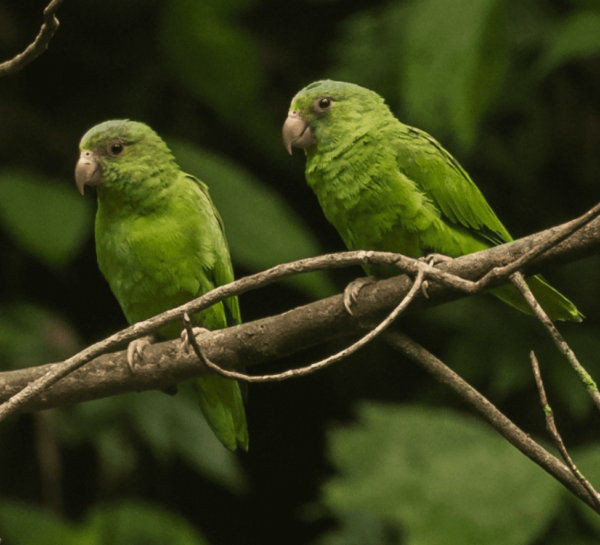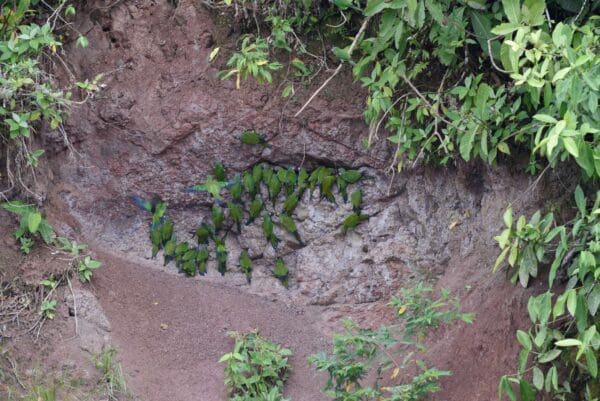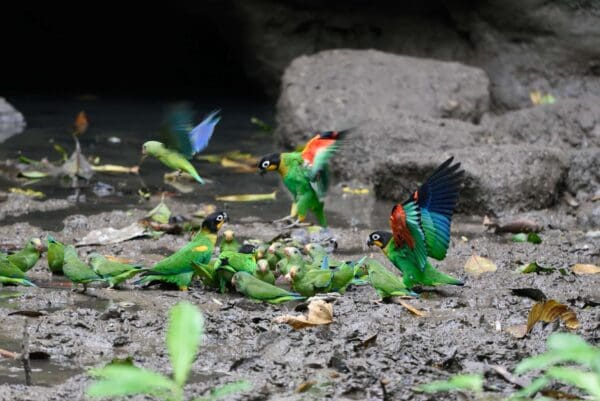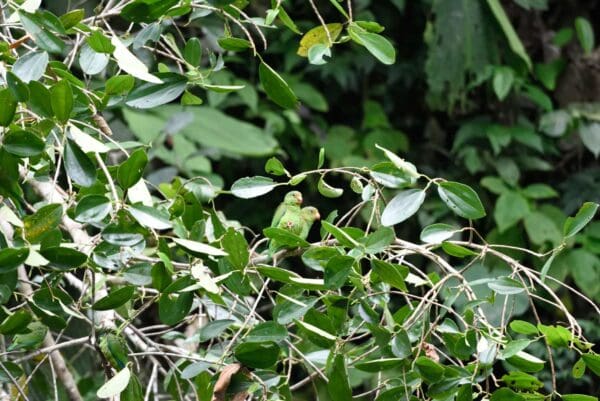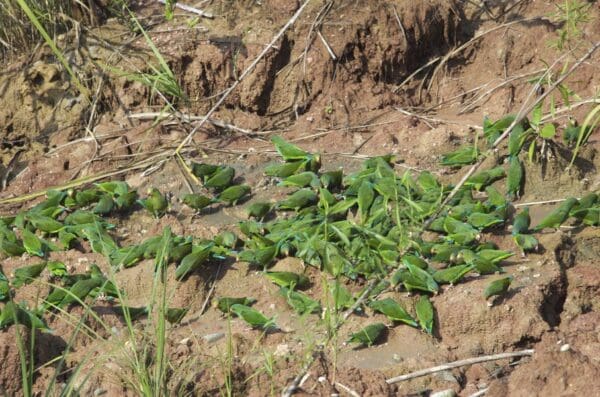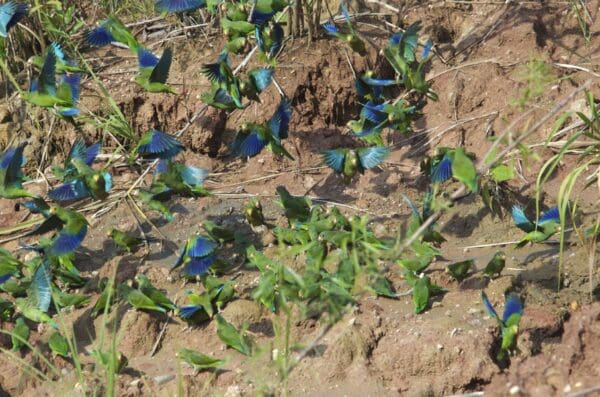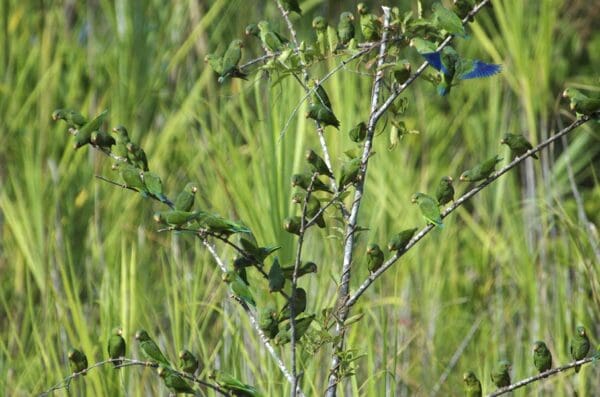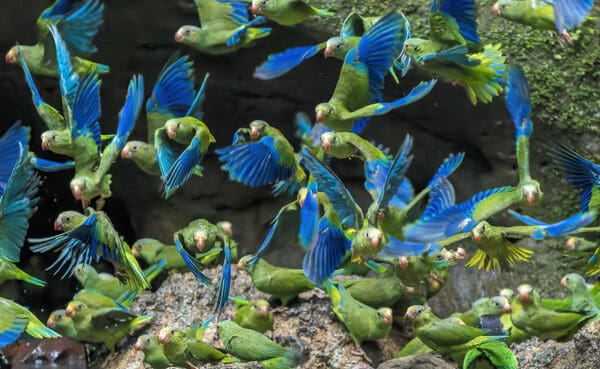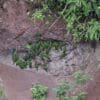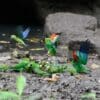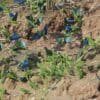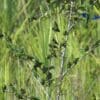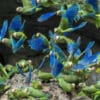Cobalt-winged Parakeet
Also known as:
Blue-winged Parakeet, Deville's Parakeet, Gustav's Parakeet (B.c. gustavi)
Also known as:
Blue-winged Parakeet, Deville's Parakeet, Gustav's Parakeet (B.c. gustavi)

Brotogeris

cyanoptera
Size:
18 cm (7 in)
Weight:
65 g (2.3 oz)
Subspecies including nominate:
three: B.c. cyanoptera, B.c. gustavi, B.c. beniensis
Colour Adult:
B.c. cyanoptera: Both adults in general yellow/green; yellow forehead and lores, duller and less far-reaching in female; chin orange; green bend of wing, carpal edge and underwing coverts; purple/blue primary coverts and secondary feathers; purple/blue outer primary feathers edged with green, the remainder purple/blue; dark blue central tail feathers with green margins, the next two green edged with blue, the remainder green. Beak pale horn in colour tipped with brown. Eye ring bare and white. Eye dark brown.
B.c. gustavi: Both adults yellow bend of wing and carpal edge; green outer primary feathers.
B.c. beniensis: Both adults as in gustavi, but paler and more yellow/green; heavy tint of yellow on forehead and lores; strong tint of blue on crown; yellow bend of wing, carpal edge, and primary coverts.
Colour Juvenile:
Duller in colour than adults. Beak brown.
Call:
Calls are described as being like those of the Tui Parakeet, rapid repetition of high pitched notes; also clear splink splink notes and harsh, scratchy noises.
More Information:
Content Sources:
CITES
BirdLife International
Cornell Lab of Ornithology/Birds of the World
Parrots: A Guide to Parrots of the World, Juniper and Parr, 1998
Parrots of the World, Forshaw and Cooper, 1977. 2010 edition
Parrots of the World, Forshaw, 2006.
Lexicon of Parrots, Thomas Arndt.
Parrots in Aviculture, Low, 1992.
Captive Status:
Uncommon.
Longevity:
—
Housing:
Aviary or suspended enclosure, minimum length 2 m (6.5 ft).
Diet:
Fruits such as: apple, pear, banana, orange, cactus fruits, pomegranates, forming about 30 percent of the diet; vegetables (if taken) such as: carrot, celery, green beans, peas in the pod; green leaves such as: Swiss chard, lettuce, sowthistle, dandelion, chickweed; spray millet; small seed mix such as: canary, millet and smaller amounts of oats, buckwheat, safflower and a little hemp; soaked and sprouted sunflower seed; cooked beans and pulses, boiled maize, and complete pellet.
Enrichment:
Enjoys bathing, so provide overhead misters or shallow bowls of water; moderate chewer, so provide browse (non-toxic, unsprayed flowering, fir, pine or willow branches.
Nest Box Size:
Nest log or vertical box, 6″ x 6″ x 6″ (15 cm x 15 cm x 15 cm).
Clutch Size:
3-6
Fledging Age:
7 weeks
Hatch Weight:
—
Peak Weight:
—
Weaning Weight:
—
World Population:
Unknown, but described as common. Decreasing.
IUCN Red List Status:
Least Concern
CITES Listing:
Appendix II
Threat Summary:
Common throughout its range with no recent trapping activity recorded. The species is considered to have a medium dependency on forest habitat, and tree cover is estimated to have declined by 5.4% within its range over the past three generations. Therefore, as a precautionary measure, it is tentatively suspected that this may have led to a 1-19% decline in the species’ population size.
Range:
B.c. cyanoptera: W Amazon basin in S Venezuela, SE Colombia and E Ecuador to E Peru, except upper Rio Huallaga valley and N Bolivia.
B.c. gustavi: Upper Rio Huallaga valley, N Peru.
B.c. beniensis: N Bolivia, in Beni and Cochabamba.
Habitat:
Found up to 1000 m (3280 ft) in lowland tropical rainforest, seasonally flooded and dry formations and semi-open savanna.
Wild Diet:
Noted visiting trees and shrubs for nectar, fruit, figs, berries and seeds; also Cecropia catkins.
Ecology and Behaviour:
Social, usually seen in flocks of up to 30 outside breeding season. Forages in the forest canopy.
Clutch and Egg Size:
3-6 rounded eggs, 23.0 x 18.5 mm (0.9 x 0.7 in)
Breeding Season:
Evidence of pair activity in June-July; nest is in tree hollow.
Related Links:
—
